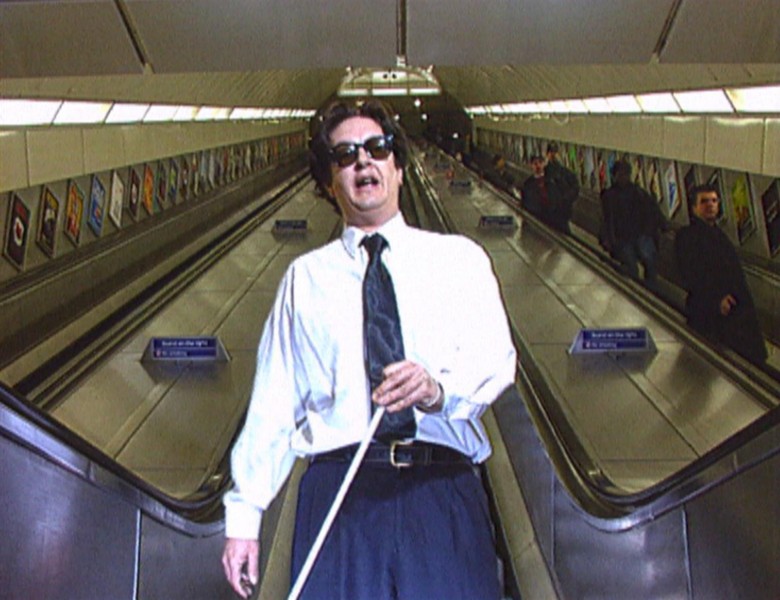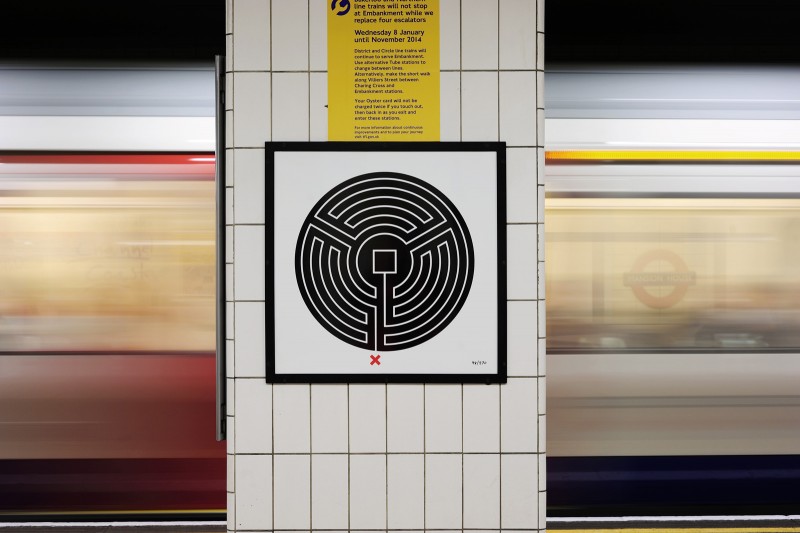Labyrinth

As a Londoner, Mark Wallinger is well acquainted with London Underground; as familiar with it, you might say, as he is with the back of his hand. He knows his way around it instinctively (he never needs to look at the map) and is aware of its history, the role it has played in shaping London itself, and the elements of design that form its instantly recognizable identity: the roundel logo, the Johnston typeface, the celebrated map, the architecture of the stations, and the works of art made for posters and other sites. All of these factors contribute to making the Tube one of the best-known and best-loved brands in the world. Wallinger also understands what the Underground means as a public place – one of the last truly democratic civic spaces, where millions of people cross paths on a daily basis as they travel around the most diverse and international of cities.
 Wallinger has explored the Tube and its significance in a number of past works, including Angel 1997, When Parallel Lines Meet at Infinity 1998, and Going Underground, 2008, the latter created as part of an on-going series of artist-produced covers for the pocket Tube map. Labyrinth represents his most ambitious Underground-related project yet. It is the only work commissioned by Art on the Underground to have a permanent presence across the entire network; as such, it is the largest commission to date. Installed over sixteen months from early 2013, to coincide with the 150th anniversary of the opening of the Tube, the work comprises 270 individual metal panels, identical in size and shape and bearing a single, unique black graphic symbol set against a white background, framed and attached to a wall in each of the system’s 270 stations. Both the fabrication of the panels in vitreous enamel and the framing and installation process replicate the tried-and-tested method for producing and fixing signage throughout the network. Created in this way, they look like they belong, yet the meaning behind them, their role and function, is not immediately obvious. How do they fit as London Underground signs? How do they even work as signs? The key is in the motif that appears on each one: a variant of a labyrinth in black with a red cross at its entrance, designed specifically for the station it occupies. There is clearly a system behind the panels, perhaps linked with that of the Tube, but like the ancient concept of the labyrinth itself there is more than a hint of a puzzle here. Recalling the shape and size of the Tube’s roundel, the various labyrinths also allude to the circuitous routes of individual journeys taken by passengers every day.
Wallinger has explored the Tube and its significance in a number of past works, including Angel 1997, When Parallel Lines Meet at Infinity 1998, and Going Underground, 2008, the latter created as part of an on-going series of artist-produced covers for the pocket Tube map. Labyrinth represents his most ambitious Underground-related project yet. It is the only work commissioned by Art on the Underground to have a permanent presence across the entire network; as such, it is the largest commission to date. Installed over sixteen months from early 2013, to coincide with the 150th anniversary of the opening of the Tube, the work comprises 270 individual metal panels, identical in size and shape and bearing a single, unique black graphic symbol set against a white background, framed and attached to a wall in each of the system’s 270 stations. Both the fabrication of the panels in vitreous enamel and the framing and installation process replicate the tried-and-tested method for producing and fixing signage throughout the network. Created in this way, they look like they belong, yet the meaning behind them, their role and function, is not immediately obvious. How do they fit as London Underground signs? How do they even work as signs? The key is in the motif that appears on each one: a variant of a labyrinth in black with a red cross at its entrance, designed specifically for the station it occupies. There is clearly a system behind the panels, perhaps linked with that of the Tube, but like the ancient concept of the labyrinth itself there is more than a hint of a puzzle here. Recalling the shape and size of the Tube’s roundel, the various labyrinths also allude to the circuitous routes of individual journeys taken by passengers every day.
In considering how to approach the commission, Wallinger noted how the special character of the Tube is expressed by any one of its famous design features, and that together these form a lexicon of its identity. Taking that as a starting point, he realized that his task was either to compete with or add to this lexicon in order to mark a particular point in its continuing story. By creating Labyrinth, he has met that challenge by adding a new element to the vocabulary of London Underground.
In many respects, Labyrinth represents what is important for Art on the Underground as a commissioner: a project that pushes the boundaries of an artist’s practice; the production of a new work that is significant for both the artist and the Underground; and a commission that many people can see and interact with and that can involve the collaboration of several individuals and organizations for its completion. True to this last ideal, the physical artwork was realized alongside an extensive public programme of talks, events, competitions and related projects, with a particular focus on young people, to ensure a widespread awareness and understanding of the project for generations to come.

This publication celebrates and adds an extra strand to the commission, further embedding the work within the folklore that surrounds the Tube and bringing more voices to the conversation around it. Thierry Bal’s extensive documentation of the project through a collection of photographs shows each and every one of the 270 Labyrinths in situ. Transport historian Christian Wolmar tells the story of the emergence and development of London’s subterranean rail network and the important role it has played in shaping the metropolis and those who live in it. Art and architecture theorist Jane Rendell considers the psychic connotations of labyrinths and the relationship between the spaces of the Tube, both above and below ground, and the hidden mind. Novelist Will Self responds to Wallinger’s piece with a personal reflection that takes us into the depths of memory and through the disorientating effects of urban life; while critic and academic Marina Warner, in conversation with the artist, explores the historic and mythological significance of the labyrinth and places the project within the context of Wallinger’s practice. We are grateful to all of the contributors for their perceptive and illuminating insights.

We must also acknowledge the commitment and dedication to the project of Mark Wallinger himself, who was invited to consider the commission more than two years before the 150th anniversary. Such an assignment would be a unique test for any artist, and Mark has created an exciting new work that will have a long legacy as part of the essence of the Tube. While he remains at the very core of Labyrinth – at the centre of the circuitous journey of discovery about the project and the meanings behind it – it is a generous work of art, one that demands and enables the participation of many others to bring it into existence and to ensure its continued integration within the life – and lives – of London Underground.
This essay was written as the Preface for Labyrinth A Journey Through London’s Underground by Mark Wallinger published in 2014 by Art Books Publishing Ltd to mark the completion of the commission Labyrinth in all London Underground stations.